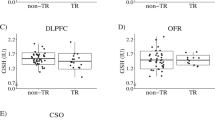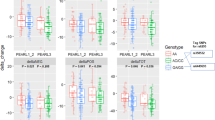Abstract
Our aim was to analyze the association of HSPA1B genotypes and treatment response measured by the changes of psychopathology and neurocognitive symptoms in patients with first-episode psychosis (FEP) after 18 months of treatment. A sample of 159 patients with FEP admitted at two Croatian psychiatric hospitals in the period between year 2014 and year 2017 was assessed at baseline and after 18 months of follow-up with Positive and Negative Syndrome Scale (PANSS), Calgary Depression Scale for Schizophrenia (CDSS) and a battery of neurocognitive tests. Associations of scale and test results with HSPA1B polymorphic locus rs1061581 were analyzed using the general linear model. The carriers of the AA genotype showed the highest improvement in CDSS and RAVLT A test after the 18-month follow-up. Concordantly, we found significantly higher improvement assessed with the CDSS, RAVLT A, RAVLT A 30′ and positive PANSS scales in the not-GG (AA/AG) group compared with the GG group. Our study suggests that HSPA1B rs1061581variants may moderate treatment response in FEP measured with changes of psychopathology and neurocognitive test results.
This is a preview of subscription content, access via your institution
Access options
Subscribe to this journal
Receive 6 print issues and online access
$259.00 per year
only $43.17 per issue
Buy this article
- Purchase on Springer Link
- Instant access to full article PDF
Prices may be subject to local taxes which are calculated during checkout
Similar content being viewed by others
References
McGrath J, Saha S, Chant D, Welham J. Schizophrenia: a concise overview of incidence, prevalence, and mortality. Epidemiol Rev. 2008;30:67–76. http://www.ncbi.nlm.nih.gov/pubmed/18480098.
Milner CM, Campbell RD. Structure and expression of the three MHC-linked HSP70 genes. Immunogenetics. 1990;32:242–51. http://www.ncbi.nlm.nih.gov/pubmed/1700760.
International Schizophrenia Consortium, Purcell SM, Wray NR, Stone JL, Visscher PM, O’Donovan MC, et al. Common polygenic variation contributes to risk of schizophrenia and bipolar disorder. Nature. 2009;460:748–52. http://www.ncbi.nlm.nih.gov/pubmed/19571811.
Bergen SE, O’Dushlaine CT, Ripke S, Lee PH, Ruderfer DM, Akterin S, et al. Genome-wide association study in a Swedish population yields support for greater CNV and MHC involvement in schizophrenia compared with bipolar disorder. Mol Psychiatry. 2012;17:880–6. http://www.ncbi.nlm.nih.gov/pubmed/22688191.
de Jong S, van Eijk KR, Zeegers DWLH, Strengman E, Janson E, Veldink JH, et al. Expression QTL analysis of top loci from GWAS meta-analysis highlights additional schizophrenia candidate genes. Eur J Hum Genet. 2012;20:1004–8. http://www.ncbi.nlm.nih.gov/pubmed/22433715.
Jia P, Wang L, Fanous AH, Chen X, Kendler KS, International Schizophrenia Consortium. et al. A bias-reducing pathway enrichment analysis of genome-wide association data confirmed association of the MHC region with schizophrenia. J Med Genet. 2012;49:96–103. http://www.ncbi.nlm.nih.gov/pubmed/22187495.
Gardiner EJ, Cairns MJ, Liu B, Beveridge NJ, Carr V, Kelly B, et al. Gene expression analysis reveals schizophrenia-associated dysregulation of immune pathways in peripheral blood mononuclear cells. J Psychiatr Res. 2013;47:425–37. http://www.ncbi.nlm.nih.gov/pubmed/23218666.
Mehta D, Klengel T, Conneely KN, Smith AK, Altmann A, Pace TW, et al. Childhood maltreatment is associated with distinct genomic and epigenetic profiles in posttraumatic stress disorder. Proc Natl Acad Sci USA. 2013;110:8302–7. http://www.ncbi.nlm.nih.gov/pubmed/23630272.
Danese A, Moffitt TE, Pariante CM, Ambler A, Poulton R, Caspi A. Elevated inflammation levels in depressed adults with a history of childhood maltreatment. Arch Gen Psychiatry. 2008;65:409–15. http://www.ncbi.nlm.nih.gov/pubmed/18391129.
Sirivichayakul S, Kanchanatawan B, Thika S, Carvalho AF, Maes M. A new schizophrenia model: immune activation is associated with the induction of different neurotoxic products which together determine memory impairments and schizophrenia symptom dimensions. CNS Neurol Disord Drug Targets. 2019;18:124–40. http://www.ncbi.nlm.nih.gov/pubmed/30451122.
Maes M, Kanchanatawan B, Sirivichayakul S, Carvalho AF. In Schizophrenia, deficits in Natural IgM isotype antibodies including those directed to malondialdehyde and azelaic acid strongly predict negative symptoms, neurocognitive impairments, and the deficit syndrome. Mol Neurobiol. 2018;56:5122–35. http://www.ncbi.nlm.nih.gov/pubmed/30484113.
Kowalczyk M, Owczarek A, Suchanek R, Paul-Samojedny M, Fila-Danilow A, Borkowska P, et al. Heat shock protein 70 gene polymorphisms are associated with paranoid schizophrenia in the Polish population. Cell Stress Chaperones. 2014;19:205–15. http://www.ncbi.nlm.nih.gov/pubmed/23893339.
Benarroch EE. Heat shock proteins: multiple neuroprotective functions and implications for neurologic disease. Neurology. 2011;76:660–7. http://www.ncbi.nlm.nih.gov/pubmed/21321339.
Bates PR, Hawkins A, Mahadik SP, McGrath JJ. Heat stress lipids and schizophrenia. Prostaglandins Leukot Ess Fat Acids. 1996;55:101–7. http://www.ncbi.nlm.nih.gov/pubmed/8888131.
Kim JJ, Lee SJ, Toh KY, Lee CU, Lee C, Paik IH. Identification of antibodies to heat shock proteins 90 kDa and 70 kDa in patients with schizophrenia. Schizophr Res. 2001;52:127–35. http://www.ncbi.nlm.nih.gov/pubmed/11595400.
Pae C-U, Kim T-S, Kwon O-J, Artioli P, Serretti A, Lee C-U, et al. Polymorphisms of heat shock protein 70 gene (HSPA1A, HSPA1B and HSPA1L) and schizophrenia. Neurosci Res. 2005;53:8–13. http://www.ncbi.nlm.nih.gov/pubmed/15963589.
Kim JJ, Mandelli L, Lim S, Lim HK, Kwon OJ, Pae CU, et al. Association analysis of heat shock protein 70 gene polymorphisms in schizophrenia. Eur Arch Psychiatry Clin Neurosci. 2008;258:239–44. http://www.ncbi.nlm.nih.gov/pubmed/18299791.
Pae C-U, Drago A, Kim J-J, Mandelli L, De Ronchi D, Serretti A. The impact of heat shock protein 70 gene variations on clinical presentation and outcome in schizophrenic inpatients. Neuropsychobiology. 2009;59:135–41. http://www.ncbi.nlm.nih.gov/pubmed/19439993.
POCIOT F, RØNNINGEN KS, NERUP J. Polymorphic analysis of the human MHC-linked heat shock protein 70 (HSP70-2) and HSP70-hom genes in insulin-dependent diabetes mellitus (IDDM). Scand J Immunol. 1993;38:491–5.
World Health Organization. The ICD-10 classification of mental and behavioural disorders: clinical descriptions and diagnostic guidelines. Geneva: World Health Organization; 1992.
Rojnic Kuzman M, Makaric P, Bosnjak Kuharic D, Kekin I, Rossini Gajsak L, Boban M, et al. Integration of complementary biomarkers in patients with first episode psychosis: research protocol of a prospective follow up study. Psychiatr Danub. 2019;31:162–71. http://www.psychiatria-danubina.com/UserDocsImages/pdf/dnb_vol31_no2/dnb_vol31_no2_162.pdf.
World Medical Association. World Medical Association Declaration of Helsinki: ethical principles for medical research involving human subjects. J Am Med Assoc. 2013;310:2191–4.
Kay SR, Fiszbein A, Opler LA. The positive and negative syndrome scale (PANSS) for schizophrenia. Schizophr Bull. 1987;13:261–76.
Addington D, Addington J, Schissel B. A depression rating scale for schizophrenics. Schizophr Res. 3:247–51.
Schmidt, M Los Angeles CWPS. Rey auditory verbal learning test: a handbook. Los Angeles: CA: Western Psychological Services; 1996.
Wechsler D. Wechslermemoryscale. San Antonio, TX, US: Psychological Corporation; 1945.
Lichtenberger EO, Kaufman AS. Essentials of WAIS-IV assessment. New Jersey: John Wiley & Sons; 2009.
Hutt ML. The Kohsblock-design tests. A revision for clinicalpractice. J Appl Psychol. 1932;16:298.
Dubois B, Slachevsky A, Litvan I, Pillon B. The FAB: a frontal assessment battery at bedside. Neurology 2000;55:1621–6.
Freedman M, Leach L, Kaplan E, Winocur G, Shulman K, Delis DC. Clock drawing: a neuropsychological analysis. Oxford University Press; Oxford, UK, 1994.
Golden CJ. Identification of brain disorders by the Stroop Color and Word Test. J Clin Psychol. 1976;32:654–8.
Tombaugh TN. Trail making test A and B: normative data stratified by age and education. Arch Clin Neuropsychol. 2004;19:203–14.
Fastenau PS, Denburg NL, Hufford BJ. Adult norms for the Rey-Osterrieth Complex Figure Test and for supplemental recognition and matching trials from the Extended Complex Figure Test. Clin Neuropsychol. 1999;13:30–47.
Folstein MF, Folstein SE, McHugh PR. “Mini-mental state”. A practical method for grading the cognitive state of patients for the clinician. J Psychiatr Res. 1975;12:189–98.
Bosnjak Kuharic D, Makaric P, Kekin I, Bajic Z, Zivkovic M, Savic A, et al. Neurocognitive profiles of patients with the first episode of psychosis and schizophrenia do not differ qualitatively: a nested cross-sectional study. Psychiatr Danub. 2019;31:43–53. http://www.psychiatria-danubina.com/UserDocsImages/pdf/dnb_vol31_no1/dnb_vol31_no1_43.pdf.
Faul F, Erdfelder E, Buchner A, Lang A-G. Statistical power analyses using G*Power 3.1: tests for correlation and regression analyses. Behav Res Methods. 2009;41:1149–60. http://www.ncbi.nlm.nih.gov/pubmed/19897823.
Python Software Foundation. Python Language Reference. Available at https://www.python.org/.
Guo SW, Thompson EA. Performing the exact test of Hardy-Weinberg proportion for multiple alleles. Biometrics. 1992;48:361–72. http://www.ncbi.nlm.nih.gov/pubmed/1637966.
Rousset F. genepop’007: a complete re-implementation of the genepop software for Windows and Linux. Mol Ecol Resour. 2008;8:103–6. http://www.ncbi.nlm.nih.gov/pubmed/21585727.
Zhang Z, Zhang R, Qin P, Tan L. Cognitive dysfunction and negative symptoms in patients with schizophrenia and their first-degree relatives from simplex and multiplex families. Neuropsychiatr Dis Treat. 2018;14:3339–48. http://www.ncbi.nlm.nih.gov/pubmed/30584307.
Maynard TM, Sikich L, Lieberman JA, LaMantia AS. Neural development, cell-cell signaling, and the “two-hit” hypothesis of schizophrenia. Schizophr Bull. 2001;27:457–76. http://www.ncbi.nlm.nih.gov/pubmed/11596847.
Trovão N, Prata J, VonDoellinger O, Santos S, Barbosa M, Coelho R. Peripheral biomarkers for first-episode psychosis-opportunities from the neuroinflammatory hypothesis of schizophrenia. Psychiatry Investig. 2019;16:177–84. http://www.ncbi.nlm.nih.gov/pubmed/30836740.
Bilbo SD, Schwarz JM. Early-life programming of later-life brain and behavior: a critical role for the immune system. Front Behav Neurosci. 2009;3:14. http://www.ncbi.nlm.nih.gov/pubmed/19738918.
Gomes FV, Grace AA. Adolescent stress as a driving factor for schizophrenia development-a basic science Perspective. Schizophr Bull. 2017;43:486–9. http://www.ncbi.nlm.nih.gov/pubmed/28419390.
Corcoran C, Mujica-Parodi L, Yale S, Leitman D, Malaspina D. Could stress cause psychosis in individuals vulnerable to schizophrenia? CNS Spectr. 2002;7:33–8. http://www.ncbi.nlm.nih.gov/pubmed/15254447.
Mizrahi R, Addington J, Rusjan PM, Suridjan I, Ng A, Boileau I, et al. Increased stress-induced dopamine release in psychosis. Biol Psychiatry. 2012;71:561–7. http://www.ncbi.nlm.nih.gov/pubmed/22133268.
Singh R, Kolvraa S, Bross P, Christensen K, Bathum L, Gregersen N, et al. Anti-inflammatory heat shock protein 70 genes are positively associated with human survival. Curr Pharm Des. 2010;16:796–801.
Mesholam-Gately RI, Giuliano AJ, Goff KP, Faraone SV, Seidman LJ. Neurocognition in first-episode schizophrenia: a meta-analytic review. Neuropsychology. 2009;23:315–36.
Henry JD, Crawford JR. A meta-analytic review of verbal fluency deficits in schizophrenia relative to other neurocognitive deficits. Cogn Neuropsychiatry. 2005;10:1–33. http://www.ncbi.nlm.nih.gov/pubmed/16571449.
Vakil E, Blachstein H. Rey auditory-verbal learning test: structure analysis. J Clin Psychol. 1993;49:883–90. http://www.ncbi.nlm.nih.gov/pubmed/8300877.
Khosravi Fard E, L Keelor J, Akbarzadeh Bagheban A, W Keith R. Comparison of the Rey Auditory Verbal Learning Test (RAVLT) and digit test among typically achieving and gifted students. Iran J child Neurol. 2016;10:26–37. http://www.ncbi.nlm.nih.gov/pubmed/27247581.
Roffman JL, Weiss AP, Deckersbach T, Freudenreich O, Henderson DC, Purcell S, et al. Effects of the methylenetetrahydrofolate reductase (MTHFR) C677T polymorphism on executive function in schizophrenia. Schizophr Res. 2007;92:181–8. http://www.ncbi.nlm.nih.gov/pubmed/17344026.
Joober R, Benkelfat C, Lal S, Bloom D, Labelle A, Lalonde P, et al. Association between the methylenetetrahydrofolate reductase 677C–>T missense mutation and schizophrenia. Mol Psychiatry. 2000;5:323–6. http://www.ncbi.nlm.nih.gov/pubmed/10889537.
Schwarz MJ, Riedel M, Gruber R, Ackenheil M, Müller N. Antibodies to heat shock proteins in schizophrenic patients: implications for the mechanism of the disease. Am J Psychiatry. 1999;156:1103–4. http://www.ncbi.nlm.nih.gov/pubmed/1040146.
Olney JW, Farber NB. Glutamate receptor dysfunction and schizophrenia. Arch Gen Psychiatry. 1995;52:998–1007. http://www.ncbi.nlm.nih.gov/pubmed/7492260.
Acknowledgements
Croatian Science Foundation No. UIP‐2014‐09‐1245 Biomarkers in schizophrenia—integration of complementary methods in longitudinal follow-up of FEP patients supported this study by the research grant.
Author information
Authors and Affiliations
Corresponding author
Ethics declarations
Conflict of interest
The authors declare that they have no conflict of interest.
Additional information
Publisher’s note Springer Nature remains neutral with regard to jurisdictional claims in published maps and institutional affiliations.
Supplementary information
Rights and permissions
About this article
Cite this article
Bosnjak Kuharic, D., Bozina, N., Ganoci, L. et al. Association of HSPA1B genotypes with psychopathology and neurocognition in patients with the first episode of psychosis: a longitudinal 18-month follow-up study. Pharmacogenomics J 20, 638–646 (2020). https://doi.org/10.1038/s41397-020-0150-9
Received:
Revised:
Accepted:
Published:
Issue Date:
DOI: https://doi.org/10.1038/s41397-020-0150-9



